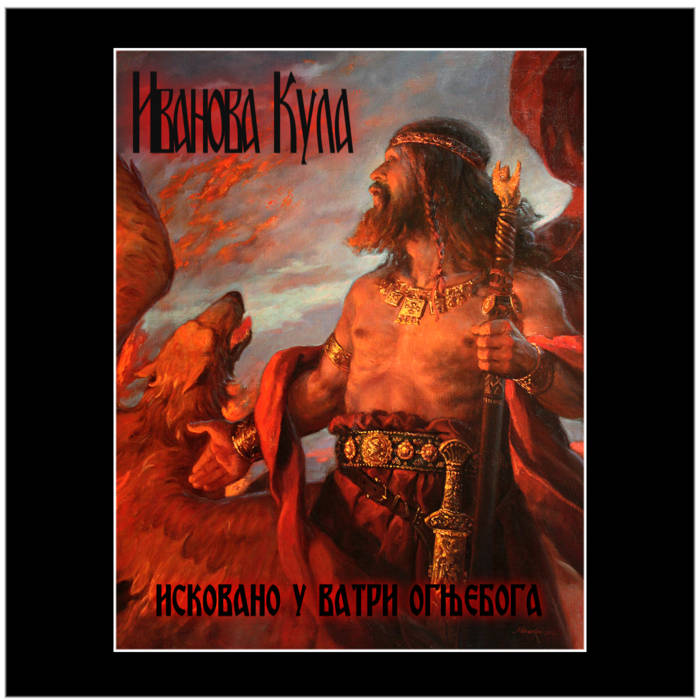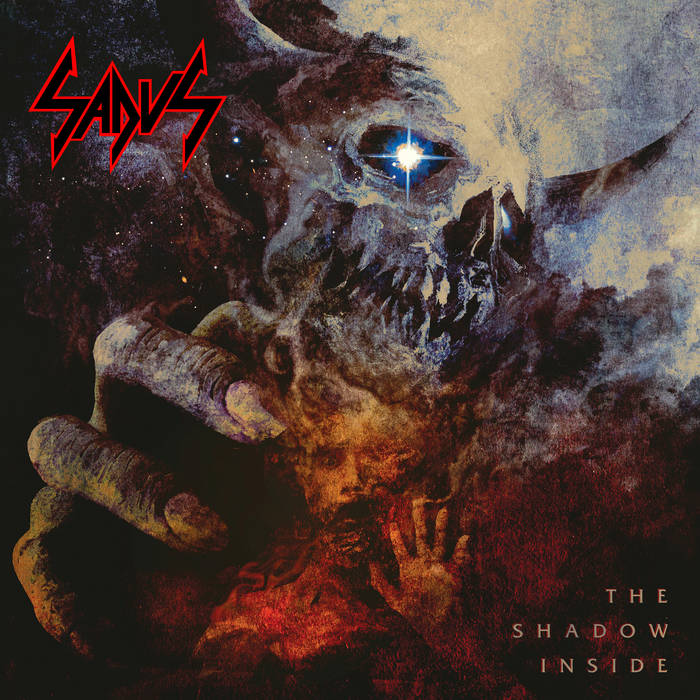Ivanova Kula: Iskovano u vatri Ognjeboga
Out 14th September, self-released

Takes metal adjacent ambient back to the halcyon days of the 1990s, when synth options were limited, recording more challenging, and – much like the fantasy gaming genre this sonic wing grew out of – artists relied on their listeners sharing an overactive imagination. Such goodwill is not unjustified. ‘Iskovano u vatri Ognjeboga’ operates with the same synth string patch throughout, relying on pulses of rhythmic harmony and pitch range to give the illusion of variance. Repetitive chord clusters jabbed with enthusiasm give the impression that this was almost recorded in one take as a series of semi-improvised vignettes. The effect is not without merit. There is a vitality, energy, and spontaneity here lacking in the majority of fantasy ambient, a genre with a fixed uniformity despite claims to the contrary. Despite the simplicity of each component part, they evince a kind of proto lyricism, a poetic conversation takes place between each passage. One reading of this album is therefore as a spoken word narrative rendered in ambient form. The simple ascending and descending lines do yet function with the linear flow of music, but work more conversationally, a simple call and response, a point then rebuttal. Those looking to get lost in a varied sound world will therefore be disappointed by this album. But ‘Iskovano u vatri Ognjeboga’ functions as a living document, a place of activity and life where so many comparable releases pose as static objects placed for listener observation alone, whereas ‘Iskovano u vatri Ognjeboga’ would seek to engage the listener in an active dialogue.
Khazad Dum: Khásma
Out 15th November on Masked Dead Records/BloodRock Records

An interesting alchemy of classic metal trappings of a pre-1980 lineage with dignified, folk infused black metal. Primitive thrash provides the connecting tissue for this marriage, offering restrained bolts of energy to motive the loose mysticism of the band’s aesthetic. Reviewing this material, originally recorded in 2019, justifies the decision to offer this album a second shot at making an impact. The use of highly traditional melodic content alongside the comforting warmth of acoustic guitars, open, fantasy informed soundscaping, and linear rhythmic progressions are presented in such a way as to feel familiar both on an intellectual and an emotive level, yet still pose as original. Soaring lead guitar work enhances the expressive range of these pieces, deployed as devices for genuine compositional progression as opposed to mere content filler. Any quotations from Saxon era NWOBHM temper the beer fuelled swing of its DNA with a restrained, narrative arc speaking more of epic fable than boner metal. A well rounded artefact of unashamedly escapist metal becomes a vehicle eking out modest pockets of novelty.
Sadus: The Shadow Inside
Out 17th November on Nuclear Blast

Lurching between styles with little direction, existing for the sake of it, riding on the coattails of a reputation long sunk into irrelevancy, in many ways the return of Sadus is emblematic of the current malaise surrounding thrash. Arriving at the tail end of thrash’s heyday, Sadus delivered some of the genre’s most extreme and at times adventurous material in the late 80s and early 90s. Having avoided their peers more embarrassing incidents of managed decline, their name still carries currency amongst connoisseurs, which is just as well, because the degree of respect due to them is about the only motivation for giving this album the time of day. This is a band totally at sea. Unsure whether to recapitulate their glory days or acknowledge the divergent threads thrash took from the 1990s onwards, throw in some groove riffs, elements of post 2000s “core” genres, or more crowd pleasing genericana, any message Sadus are trying to convey is lost beneath a need to generate content for its own sake. Metal has long been cannibalised by legacy bands eating their young, an utter refusal for the past to step aside and make way for the present. The sterile (but not too sterile) production, the need to hit as many modern metal tropes as is feasible, the faux angst, all speaks of an undignified generational deadlock. It would be unfair to lay all this at Sadus’s door. But so pointless and late in the day is this unwanted “return to form” tantrum of brat metal that one can’t but wonder what Sadus actually think they’re achieving here.
Dughpa: 4
Out 24th November on Helter Skelter Productions/Regain Records

Pays the same visit to the Berlin school that Fenriz’s long defunct pet project Neptune Towers did, but attempts a more explicit marriage with the spirit if not the forms of black metal. The result is the realisation of what dungeon synth’s darker wing purports – but so often fails – to be. A drab retro futurism coats the album, using a timbral range lifted from the 1970s to organically evolve fragile melodic lines as opposed to the rigid arpeggio revolutions of Tangerine Dream. Static ambient serves as a backdrop, mirroring the stasis of natural wilderness in echoes of Ildjarn’s ‘Landscapes’. One also cannot ignore Burzum’s ambient legacy from ‘Hvis lyset tar oss’ through to ‘Filosofem’ in its use of rigid minimalism as a project of world building. An attempt to strip back the excess matter of complexity, granting space and light for new ideas to tentatively emerge from the newly turned soil. In many ways “4” represents the true sequel to Burzum’s pre-prison ambient ambitions. The pieces are short, but take on long form function if treated as a continuum of suites, gradually progressing through separate but related iterations around the same cluster of ideas. With each component part taking up the mantle of lead instrument for a brief period before handing to the next, each recasting the same basic idea until it is ready to be discarded.
Swords of Dis: Melencolia
Out 24th November on I, Voidhanger

2021’s ‘Cor Mundum Crea in Me, Sanctum Ignis’ saw Swords of Dis stand at a threshold. They straddled the borders between gothic doom, dissonant black metal, industrial dark ambient flavours, and an undulating, meandering approach to melodic and rhythmic evolution most directly inherited from death metal. Given the briefness of the EP, marshalling such a stylistic breadth into anything remotely coherent was alone cause for praise. But it placed them on the horns of a dilemma. Sharing the same aesthetic territory as metal’s Disney wing doesn’t automatically bar one from legitimacy, but it does increase the risk of internalising a certain stripe of vulgarity, which regrettably is exactly what has occurred here. ‘Melencolia’ is engulfed by a gauche concoction of contrived melodrama lifted from the very bin of populist extreme metal itself. Names likes Behemoth, latter day SepticFlesh, Fleshgod Apocalypse, and even Theatre of Tragedy come to mind on subjecting oneself to this fairground ride of plastic goth props, hammy English melodrama trying – and failing – to wrestle with the legacies of Bram Stoker, Shakespeare, or Mary Shelley. The dissonance that served them so well previously has been relegated to mere link phrases, deployed to rough up the edges of this sickly sweet product, and fool the kids into thinking that this is somehow adjacent to intellectualism. For the rest, chugging pop metal disguised as symphonics, rock banality posing as bright euphoria, and flashes of a fully realised riff philosophy appearing more by accident than design.
Aphelium Aeternum: Dark Interstellar Mysteries
Out 1st December on Dominance of Darkness

Fast, rich, flowing symphonic black metal that understands the aura of early Emperor if not its architecture. Indeed, the entire album feels like a celebration (wake?) of black metal at its most elaborately ornamental. The themes themselves are simple. But would it be fair to describe them as themes as opposed to riffs, which is at least indicative of a degree of understanding when it comes to the motivators of symphonic black metal. The development is modest. But it’s there, and it carries a certain intuitive charm that holds the attention. The delivery around this central compositional background is where the bells and whistles are, and is also the reason why this feels more competent pastiche than genuine article. Histrionic vocals, rich synth layers, a near constant flow of fluid blast-beat ridden drum work, and a barrage of Nordic black metal’s greatest hits as far as guitar technique and chord constructions are concerned. Aphelium Aeternum understand their craft well, but are only adept enough to provide a reasonable simulation of symphonic black metal as an experience, falling short in bringing these pieces off the page and truly to life. But in this they have already surpassed the majority of their peers in displaying an intimacy with their source material, and an ability to at least concoct a facsimile from the ashes. Enthusiasm and class plug any gaping holes in this material, thus landing us with a serviceable listening experience.
“Boner metal.”
Heh.
LikeLike